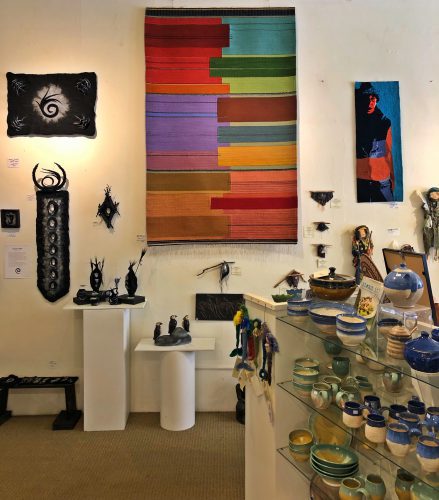
Written by Jason Palumbo
A moment of awe. A sense of wonder. An intimate feeling of connection.
These are the sensations visitors report on entering Markings Gallery for the first time. They are the sensations I felt on finding myself in Markings after moving with my wife from New York City to a small community in mid-coast Maine. Markings, an artists’ cooperative with three large display rooms nestled on a lively little street in the shipbuilding town of Bath, is the rare shop that you bring all your out-of-town friends and relatives to see. There’s a magic to Markings that needs to be shared.
Markings Gallery is currently celebrating its 10-year anniversary. Normally, Markings, known in the community for its gallery shows and artists talks, would throw a big bash to mark this accomplishment, but not this year, with protocols requiring masks and physical distancing of patrons. Yet even in these strange times, a local treasure like Markings has earned a moment of recognition and celebration.
It is a big accomplishment for a gallery that is run by and for artists to reach the one-decade mark in such an expansive storefront. It’s rare for a gallery of this kind to thrive for so long. Markings does not buy art to upsell, and it does not feature any works by artists who are not Maine residents. Markings is an artists’ cooperative featuring 60 of the finest artists and craftspeople that Maine has to offer. The gallery prides itself on being a place for artists to sell art the way that they want to, a platform for its members to reach enthusiasts, fans, and collectors.
Fans and enthusiasts might sound like hyperbole for a craft store in a sleepy town off Route 1, but the fans proved themselves to be very much that when they voted with their dollars this spring. When the pandemic struck, and all the retail shops in coastal Maine went into lockdown, many galleries had to fold. Other wonderful shops near Markings along Front Street in Bath boarded up for good. Nan Kilbourn-Tara, the founder and acting manager of Markings, would not go down without a fight. She gathered the members of the cooperative together and planned an online fundraiser to carry the gallery through these lean times. It turned out that Markings had more than fans. They had committed supporters. They had patrons in the truest sense of the word. They met their fundraising goal within three weeks.
Kilbourn-Tara is an experienced businesswoman and talented tile artist who exudes confidence and genuineness, and in speaking with her, I got a sense of what makes Markings such a special place in the community.
“You know, I’ve heard more than once that we stack up with the best craft shops in America from people coming from New York, Boston, Philadelphia,” she said. “The diversity and excellence of our artists’ work is our strength. Keeping both the mix and the balance exciting is our challenge, and that recipe is always changing. We work hard to find the best of the best.”
Markings is the second artists’ cooperative that Kilbourn-Tara has successfully helmed. In 1976, a well-received Maine craft show called Directions in Maine Living launched in Portland. Kilbourn-Tara saw that the show had opened the eyes of people in the art world to the true talent of Maine artists and their handmade objects, and she jumped at the opportunity to expand on the show’s success. That very year, she convened with local artists and opened Praxis Gallery on Main Street in Freeport. It thrived for 17 years. According to Kilbourn-Tara, several factors led to the closing of Praxis, but the main reason was due to the town of Freeport having changed so dramatically.
“Freeport had become a town with high rents and mostly outlet stores that many of the gallery’s customers chose to avoid. It was no longer the ideal location for a cutting-edge Maine crafts gallery.”
Fast forward to 2010 and the birth of Markings Gallery.
“A small group of artist friends gathered in my home in West Bath,” Kilbourn-Tara recalled. “We began reminiscing about the Praxis years and what a special gallery it was. I mentioned that I had seen a wonderful gallery space for rent in Bath. Suddenly the spark was lit. We began the brainstorming process that ultimately led to creating a diverse group of craft artists. Markings Gallery was on its way.”
The group chose to use the same business formula that had worked so well at Praxis. The income from each piece would go directly to the artist with a percentage deducted to cover the costs of running the gallery. No profit is taken by a gallery owner, as one does not exist. With this financial structure, the artists are all working together, for themselves, but also for each other. The gallery is a success only if each artist succeeds.
While Markings has no owner or executives, it does have strong leadership. In addition to Kilbourn-Tara, the other chief leader of Markings, the gallery’s manager, is a skilled textile artist named Susan Mills.
It was Mills’ work that most captivated me and kept me coming back every time I found myself in Bath. In fact, I was so taken with her work that I introduced myself and cajoled her into teaching the art of wet-felting just so I could understand how she imbued such a spirit into her felted creations. Mills credits Kilbourn-Tara with the store’s ongoing success when it comes to finding the right balance of ever-changing talent across a broad range of media. She also points to Kilbourn-Tara’s artistic eye in the staging of the new art in concert with the hugely diverse array of pieces to be found in the gallery.
“Nan does the curating and brings her own keen vision to every piece that comes in the gallery,” Mills said. “She puts a lot of energy into staging the gallery. Consideration is always given to see how pieces work together with colors, textures and symbolism.
Whenever Markings has taken on a new artist, there are lots of conversations that precede this. The art is highly juried. It has worked well for them.
The gallery is always populated by a diverse range of media, from fiber art to ceramics to jewelry to wood carvings. There are currently two artists with stained glass work in the gallery, and another artist makes small glass objects and ornaments.
This is what happens when a gallery is run entirely by the artists. The spirit of the place is focused on the pieces, rather than the profits. Markings is deeply authentic. It is a place to luxuriate in art for the sake of art, craft for the celebration of skillful eyes and hands. It is a place that makes you feel. A visitor described it as feeling like being in a museum but more accessible. Each piece has meaning, authenticity, and is one of a kind.
Kilbourn-Tara and Mills stressed to me their gratitude to the patrons who value them strongly enough to make the fundraiser a success and to come back to see them year after year. They hope, even though they can’t responsibly throw the 10-year anniversary party that the store, its fans, and the town deserve, that people will still be able to come and celebrate in their own way, with smaller, more intimate celebrations of what the gallery means to each individual.
Markings Gallery is still open. It is still a place to be inspired. Reflecting on the success of the store and the fundraising drive that carried it through the statewide shutdown, Mills said, “I think it shows what people truly value. Art feeds the soul.”
Categories: Announcement, Bath
Tags:

